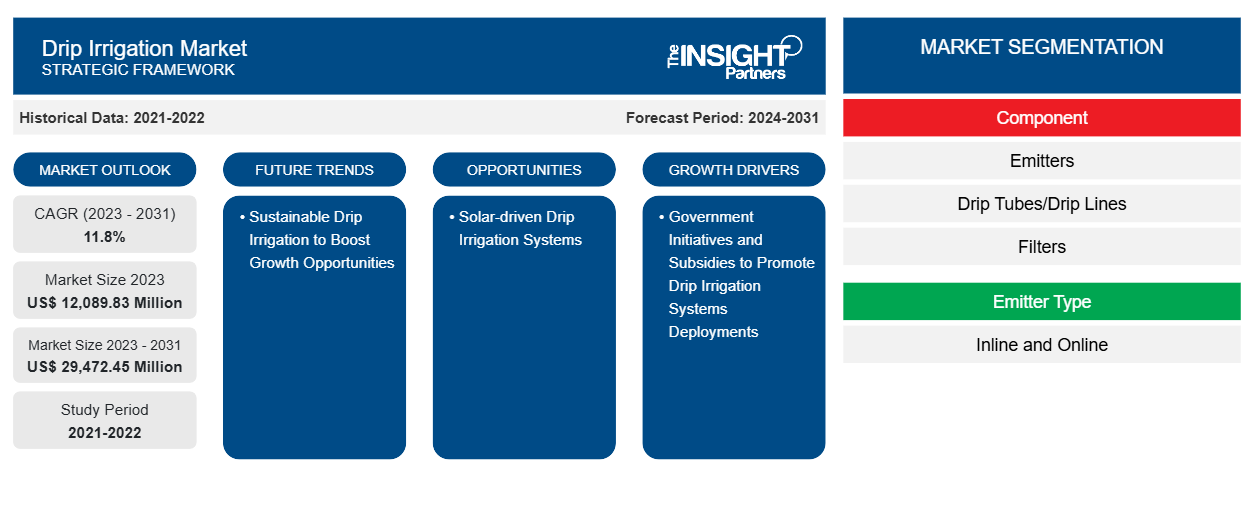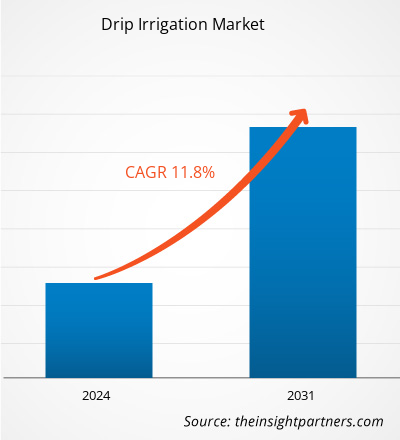The drip irrigation market size is projected to reach US$ 29,472.45 million by 2031 from US$ 12,089.83 million in 2023. The market is expected to register a CAGR of 11.8% during 2023–2031. The growing advent of solar-driven drip irrigation systems is likely to remain a key trend in the market.
Drip Irrigation Market Analysis
Growing demands for a zero-carbon, technologically advanced micro-irrigation system that works well in farms of every size and can be installed using the existing field infrastructure are driving the growth of the global drip irrigation market. The evolution of the drip irrigation market is credited to several aids of drip irrigation, such as augmented plant productivity and improved quality, disease prevention by curtailing water contact with the leaves, reduced weed growth, and declined labor requirements.
Drip Irrigation Market Overview
The major stakeholders in the global Drip Irrigation market ecosystem include raw material suppliers, Drip Irrigation manufacturers, and end-users. The raw material supplier is a crucial stakeholder in the ecosystem of the Drip Irrigation market. The Drip Irrigation manufacturers are Jain Irrigation, Netafim, Lindsay Corp, Hunter Industries and Rain Bird Industries. The major end-users of the drip irrigation market include agriculture, greenhouses and others.
Customize This Report To Suit Your Requirement
You will get customization on any report - free of charge - including parts of this report, or country-level analysis, Excel Data pack, as well as avail great offers and discounts for start-ups & universities
Drip Irrigation Market: Strategic Insights

- Get Top Key Market Trends of this report.This FREE sample will include data analysis, ranging from market trends to estimates and forecasts.
You will get customization on any report - free of charge - including parts of this report, or country-level analysis, Excel Data pack, as well as avail great offers and discounts for start-ups & universities
Drip Irrigation Market: Strategic Insights

- Get Top Key Market Trends of this report.This FREE sample will include data analysis, ranging from market trends to estimates and forecasts.
Drip Irrigation Market Drivers and Opportunities
Government Initiatives and Subsidies to Promote Drip Irrigation Systems Deployments to Favor Market
The governments of various developing countries like India decided to provide financial assistance to farmers and initiated an awareness campaign to encourage a maximum number of farmers to switch to drip and sprinkler irrigation methods. The government of Maharashtra, India, decided to increase subsidies to promote micro-irrigation schemes in 2021. Farmers are implementing novel technologies such as sprinkler irrigation, which significantly drives the progression of micro irrigation systems across Germany. Thus, the rising government focus on irrigation systems is acting as a major driver for the market.
Solar-driven Drip Irrigation Systems
The mounting amalgamation of advanced technologies in small irrigation projects to mitigate the hostile impacts of climate change and increasing instances of droughts is likely to create significant expansion possibilities for the drip irrigation market. The increasing consciousness regarding the advantages of drip irrigation for improving economic growth, a upsurge in private sector programs, and extended government fund facilities and loans to farmers to capitalise in these technologies are predicted to increase the drip irrigation market size from 2023 to 2031.
Drip Irrigation Market Report Segmentation Analysis
Key segments that contributed to the derivation of the drip irrigation market analysis are component, emitter type, application and type.
- Based on the component, the drip irrigation market is divided into emitters, drip tubes/drip lines, filters, valves, pressure pumps, and others. The emitters segment held a larger market share in 2023.
- Based on the emitter type, the drip irrigation market is divided into inline and online. The online segment held a larger market share in 2023.
- By application, the market is segmented into agriculture, greenhouse, and others. The agriculture segment held a significant share of the market in 2023.
- By type, the market is segmented into surface and subsurface. The subsurface segment held a significant share of the market in 2023.
Drip Irrigation Market Share Analysis by Geography
The geographic scope of the drip irrigation market report is mainly divided into five regions: North America, Asia Pacific, Europe, Middle East & Africa, and South & Central America.
Asia Pacific is leading the market. Asia Pacific is a highly populated region across the world, having a higher demand for energy. APAC is one of the developing economic region with China and India. Japan is one of the most technologically advanced country in the region, supporting the development of a drip irrigation market. North America is a technologically advanced region. Smart technologies have witnessed high adoption in this region. These technologies, when integrated with drip irrigation systems, provide efficiencies to the end users. More deployments call for more competition in the region along with the growth of the entire market leading to market development and innovations.
Drip Irrigation Market Regional Insights
The regional trends and factors influencing the Drip Irrigation Market throughout the forecast period have been thoroughly explained by the analysts at The Insight Partners. This section also discusses Drip Irrigation Market segments and geography across North America, Europe, Asia Pacific, Middle East and Africa, and South and Central America.
Drip Irrigation Market Report Scope
| Report Attribute | Details |
|---|---|
| Market size in 2023 | US$ 12,089.83 Million |
| Market Size by 2031 | US$ 29,472.45 Million |
| Global CAGR (2023 - 2031) | 11.8% |
| Historical Data | 2021-2022 |
| Forecast period | 2024-2031 |
| Segments Covered |
By Component
|
| Regions and Countries Covered | North America
|
| Market leaders and key company profiles |
|
Drip Irrigation Market Players Density: Understanding Its Impact on Business Dynamics
The Drip Irrigation Market is growing rapidly, driven by increasing end-user demand due to factors such as evolving consumer preferences, technological advancements, and greater awareness of the product's benefits. As demand rises, businesses are expanding their offerings, innovating to meet consumer needs, and capitalizing on emerging trends, which further fuels market growth.

- Get the Drip Irrigation Market top key players overview
Drip Irrigation Market News and Recent Developments
The drip irrigation market is evaluated by gathering qualitative and quantitative data post primary and secondary research, which includes important corporate publications, association data, and databases. A few of the developments in the drip irrigation market are listed below:
- The Toro Company expanded its precision irrigation Toro Aqua-Traxx Azul product line. Ultra-low flow options have been added to improve the performance. (Source: The Toro Company, Press Release, March 2022)
- Rivulis Irrigation Ltd. opened its state-of-the-art factory in North America. This will expand the capacity of North American manufacturing. (Source: Rivulis Irrigation Ltd, Press Release, April 2022)
Drip Irrigation Market Report Coverage and Deliverables
The “Drip Irrigation Market Size and Forecast (2021–2031)” report provides a detailed analysis of the market covering below areas:
- Drip irrigation market size and forecast at global, regional, and country levels for all the key market segments covered under the scope
- Drip irrigation market trends as well as market dynamics such as drivers, restraints, and key opportunities
- Detailed PEST and SWOT analysis
- Drip irrigation market analysis covering key market trends, global and regional framework, major players, regulations, and recent market developments
- Industry landscape and competition analysis covering market concentration, heat map analysis, prominent players, and recent developments for the drip irrigation market
- Detailed company profiles
Frequently Asked Questions
Which region dominated the drip irrigation market in 2023?
What are the future trends of the drip irrigation market?
Which are the leading players operating in the drip irrigation market?
What would be the estimated value of the drip irrigation market by 2031?
What is the expected CAGR of the drip irrigation market?
- Historical Analysis (2 Years), Base Year, Forecast (7 Years) with CAGR
- PEST and SWOT Analysis
- Market Size Value / Volume - Global, Regional, Country
- Industry and Competitive Landscape
- Excel Dataset
Recent Reports
Testimonials
Reason to Buy
- Informed Decision-Making
- Understanding Market Dynamics
- Competitive Analysis
- Identifying Emerging Markets
- Customer Insights
- Market Forecasts
- Risk Mitigation
- Boosting Operational Efficiency
- Strategic Planning
- Investment Justification
- Tracking Industry Innovations
- Aligning with Regulatory Trends





















 Get Free Sample For
Get Free Sample For